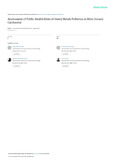Assessment of Public Health Risks of Heavy Metals Pollution in River Sosiani Catchment

View/
Date
2019-10-09Author
Shieund, Ogara Rose
Neyole, Edward
Omuterema, Stanley
Orata, Francis
Metadata
Show full item recordAbstract
The objective of the study was to assess public health risks of heavy metals pollution in river Sosiani
Catchment. This study was a multiple design approach whereby both experimental and socio-economic survey was
done to obtain data. The units of analysis used in the socio-economic phase of the study were a random sample size
of 402 WRUA members while the scientific phase of the study included two species of fish and water. Water was
sampled from eleven sampling locations (SR0 – SR10) and fish from ten sampling points (SR1 – SR10) along river
Sosiani. Data for the WRUA members was obtained through weighing and questionnaire analysis. Data for water
and fish was obtained using AAS. Data analysis was done using the statistical program for social sciences (SPSS)
version 23. The inherent public health risks from heavy metal exposure were determined using THQs for the
respective heavy metals and HI which summed up the individual THQs. During the wet season, THQs for water
revealed that all sites showed no potential risk for lead, only one site; Naiber exhibited the high risk values for
cadmium and three sites, registered very high THQs way beyond the threshold of 1 for chromium. Two sites
(Nairobi bridge and Kisumu bridge) had HI values above the limit of 3. During the dry season,both lead and
cadmium showed very low THQ values for water, indicating no risk potential. Only chromium had high THQ values
in five sites indicating high health risks. The trend was similar for the wet season for HI. An analysis of the risks
from fish consumption of Barbus and catfish for both seasons showed that within the entire catchment and based on
the received responses, the public health risk from fish consumption is very low with THQs being way below the
threshold value of 1 for all the heavy metals (Pb, Cd and Cr). An evaluation of risks as exhibited by manifestation of
symptoms within the catchment indicated that most of the inhabitants were symptomatic. Basically, it is concluded
that water from river Sosiani had higher THQ and HI values and hence higher risk values than both the fish species.
This rendered water from this location unfit for human consumption. The study recommends that urgent measures
like pollution control through enforcement of the Kenyan regulations and proper engineering guidance for drainages
and wastewater treatment plants will reverse and eventually stop this trend. The communities are also supposed to be
sensitised and encouraged not to use river water for domestic use
Collections
- Journal Articles [411]
